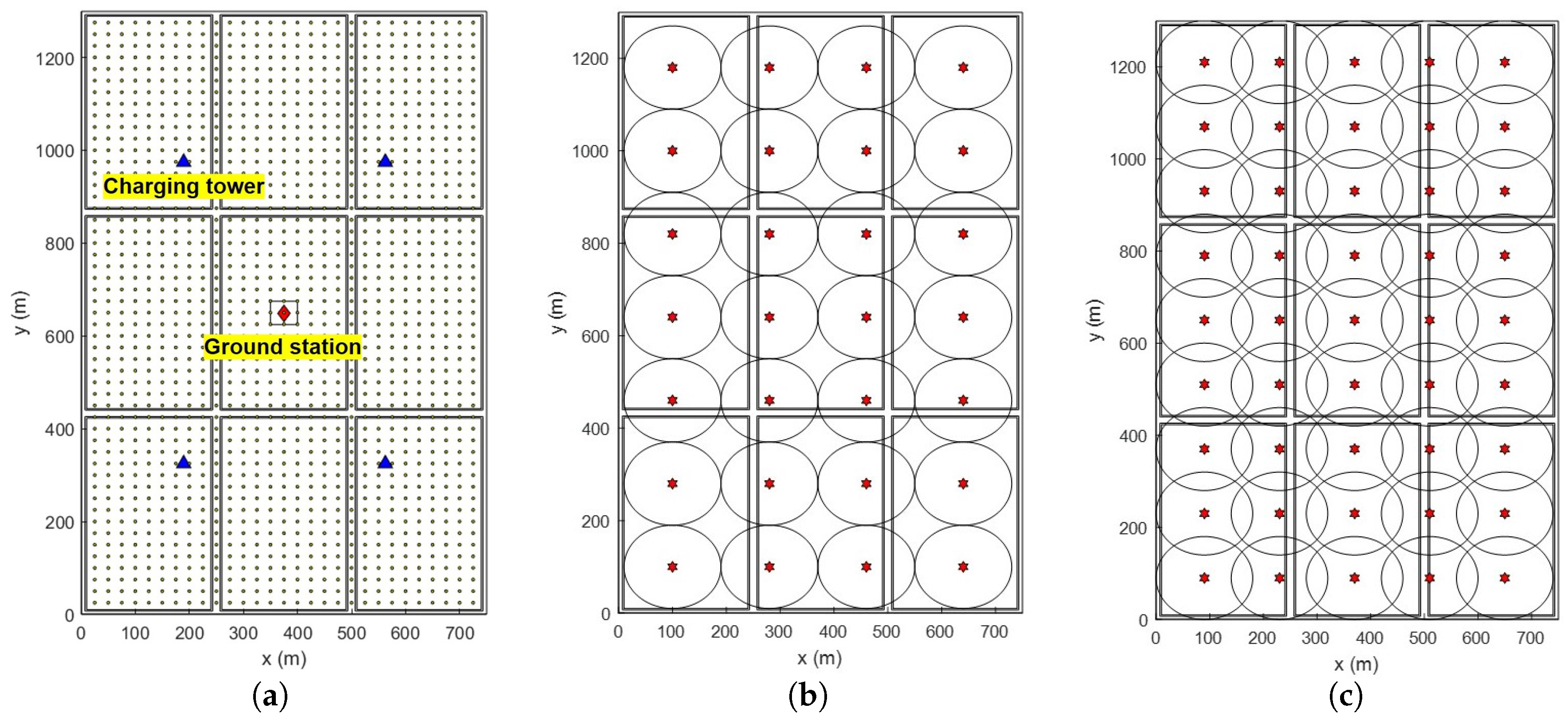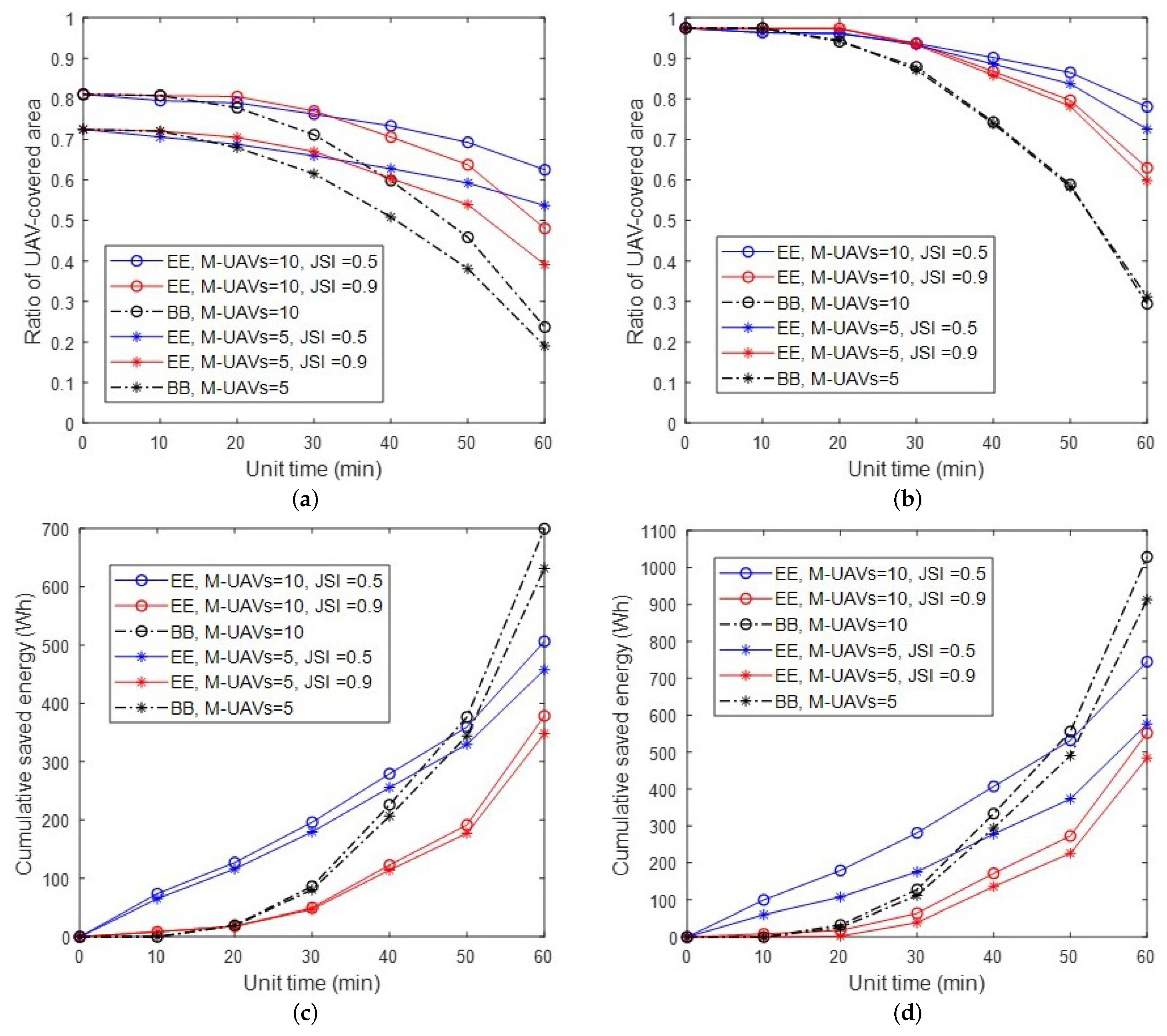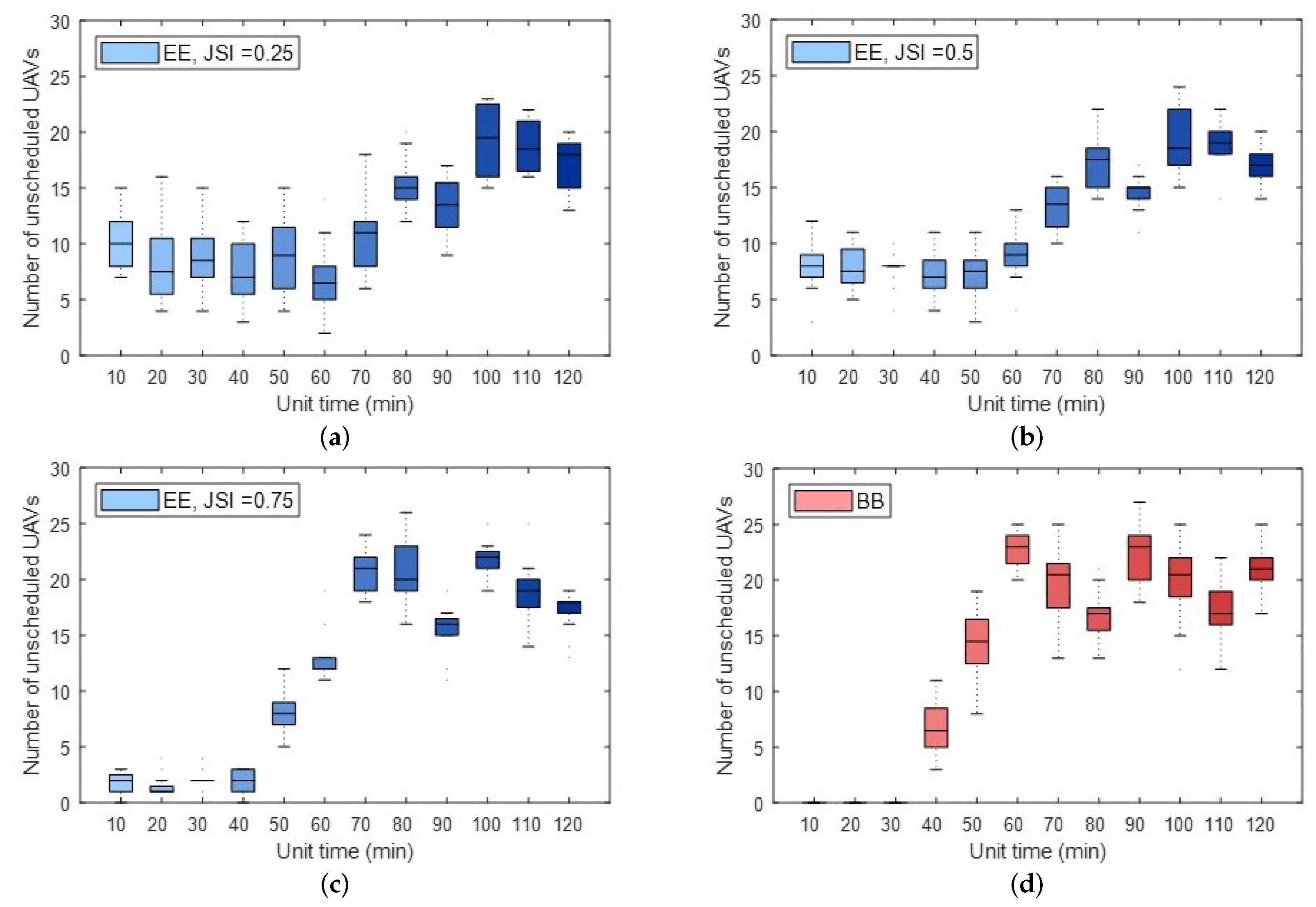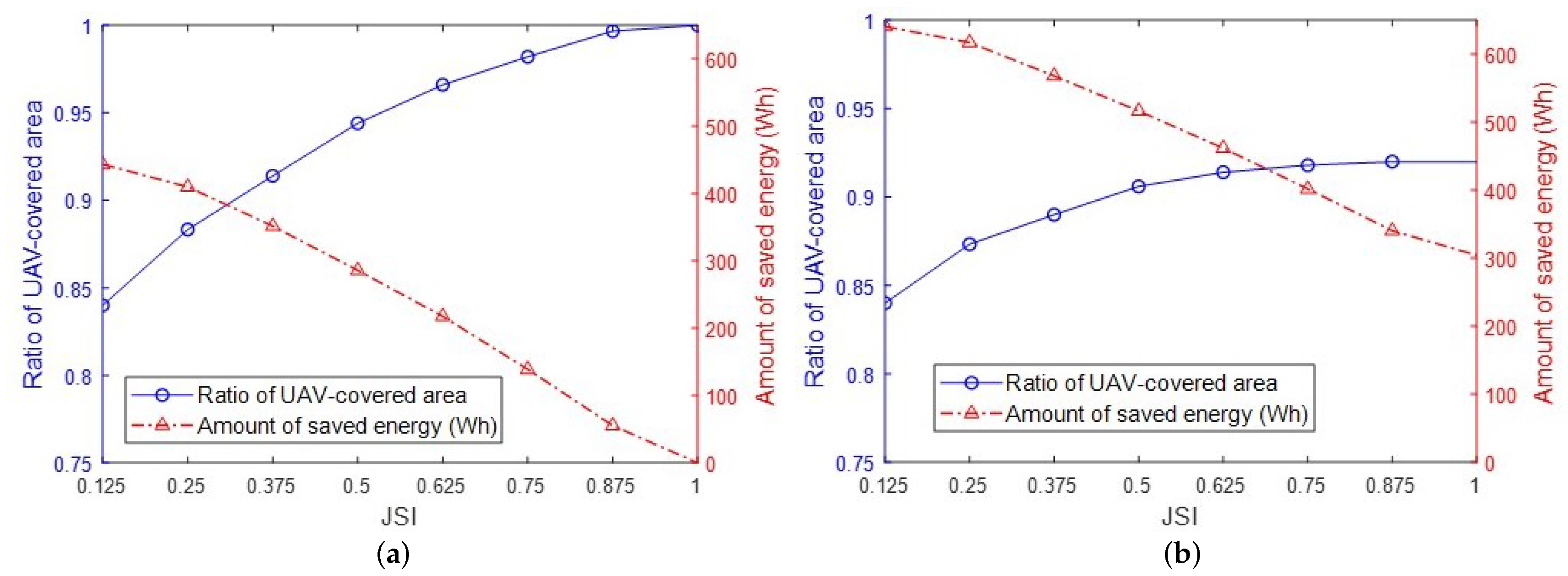Joint Message-Passing and Convex Optimization Framework for Energy-Efficient Surveillance UAV Scheduling
Abstract
1. Introduction
- This research is the first attempt to characterize the overlapping surveillance areas with MWIS formulation that is feasible in practice. In the MWIS-based model, we design a novel solution approach that is based on the concept of message-passing.
- We determine that the optimization problem for joint matching and energy allocation between UAVs and charging towers is non-convex. We then present a novel method for transforming the non-convex formulation into the convex programming, thus achieving optimal solutions.
- In addition to the theoretical novelties, we conduct data-intensive simulations with various simulation settings. It is demonstrated that our joint matching and energy allocation method remarkably outperforms several baseline schemes. Furthermore, our proposed matching and energy allocation algorithm between UAVs and charging towers presents the desired performance improvement.
2. Related Work
3. System Model
4. Joint Message-Passing and Convex Optimization Framework for UAV Scheduling
4.1. Design Concepts and Contributions
- First, MWIS-based scheduling is conducted to select UAVs whose cameras can be turned off when the corresponding target areas are monitored by other UAVs (i.e., visually overlapping areas). According to this scheduling, the operational energy consumption for the selected UAVs can be reduced and their surveillance lifetime can be extended. In order to solve this MWIS-based scheduling problem, message-passing is used in this paper because it is a well-known solution for this type of combinatorial problem. More details are in Section 4.2.1.
- Furthermore, the unscheduled UAVs are moved to the charging towers to be charged with wireless energy transfer technologies. Subsequently, our proposed optimization framework determines the charging matching of UAVs to charging towers. In addition, each tower determines how much energy should be delivered to the matched UAVs in order to conduct this matching decision in each unit time. This formulation is a mathematically non-convex optimization; however, we converted the corresponding non-convex terms into convex terms (i.e., the polynomial-time operation can be realized for the given joint matching and charging optimization formulation). More details are in Section 4.2.2.
4.2. Algorithm Details
4.2.1. MWIS-Based UAV Scheduling via Message-Passing
| Algorithm 1 Message-passing for MWIS-based energy-efficient surveillance scheduling |
|
4.2.2. Joint Optimization for Charging Matching and Wireless Energy Transfer
4.3. Computational Complexity
5. Performance Evaluation
5.1. Simulation Setup
- Scenario 1 (sparse lattice grid): 28 F-UAVs monitor the entire map without overlapping areas.
- Scenario 2 (dense lattice grid): 45 F-UAVs monitor the entire map with overlapping areas that are fully covered without any blank space.
- Scenario 3 (random): 20 F-UAVs are uniform-randomly distributed within the map.
- First, all of the UAVs perform their own major tasks (i.e., monitoring at their locations to the extent of their batteries). The charging tower controller checks the status of each battery of the UAVs and suspends the surveillance functionality if the battery remains below 30%.
- Next, the UAVs with battery status values of less than 30% select the nearest charging tower from their locations if the charging tower has available charging panels.
5.2. Evaluation Results
6. Concluding Remarks
Author Contributions
Funding
Acknowledgments
Conflicts of Interest
References
- Shen, Y.; Pan, Z.; Liu, N.; You, X. Joint Design and Performance Analysis of a Full-Duplex UAV Legitimate Surveillance System. Electronics 2020, 9, 407. [Google Scholar] [CrossRef]
- Abdallah, A.; Ali, M.Z.; Mišić, J.; Mišić, V.B. Efficient Security Scheme for Disaster Surveillance UAV Communication Networks. Information 2019, 10, 43. [Google Scholar] [CrossRef]
- Kim, J.; Caire, G.; Molisch, A.F. Quality-Aware Streaming and Scheduling for Device-to-Device Video Delivery. IEEE/ACM Trans. Netw. 2016, 24, 2319–2331. [Google Scholar] [CrossRef]
- Lee, H.; Lee, K.-J.; Kim, H.; Lee, I. Wireless Information and Power Exchange for Energy-Constrained Device-to-Device Communication. IEEE Internet Things J. 2018, 5, 3175–3185. [Google Scholar] [CrossRef]
- Asiedu, D.K.P.; Lee, H.; Lee, K.-J. Simultaneous Wireless Information and Power Transfer for Decode-and-Forward Multihop Relay Systems in Energy-Constrained IoT Networks. IEEE Internet Things J. 2019, 6, 9413–9426. [Google Scholar] [CrossRef]
- Na, W.; Park, J.; Lee, C.; Park, K.; Kim, J.; Cho, S. Energy-Efficient Mobile Charging for Wireless Power Transfer in Internet of Things Networks. IEEE Internet Things J. 2018, 5, 79–92. [Google Scholar] [CrossRef]
- Lee, H.; Lee, S.-R.; Lee, K.-J.; Kong, H.-B.; Lee, I. Optimal Beamforming Designs for Wireless Information and Power Transfer in MISO Interference Channels. IEEE Trans. Wirel. Commun. 2015, 14, 4810–4821. [Google Scholar] [CrossRef]
- Park, L.; Jeong, S.; Lakew, D.S.; Kim, J.; Cho, S. New Challenges of Wireless Power Transfer and Secured Billing for Internet of Electric Vehicles. IEEE Commun. Mag. 2019, 57, 118–1241. [Google Scholar] [CrossRef]
- Al-Khafajiy, M.; Baker, T.; Hussien, A.; Cotgrave, A. UAV and Fog Computing for IoE-Based Systems: A Case Study on Environment Disasters Prediction and Recovery Plans. In Unmanned Aerial Vehicles in Smart Cities; Springer: Cham, Switzerland, 2020; Volume 1, pp. 133–152. [Google Scholar]
- Mozaffari, M.; Saad, W.; Bennis, M.; Nam, Y.-H.; Debbah, M. A Tutorial on UAVs for Wireless Networks: Applications, Challenges, and Open Problems. IEEE Commun. Surv. Tutor. 2019, 21, 2334–2360. [Google Scholar] [CrossRef]
- Mozaffari, M.; Kasgari, A.T.Z.; Saad, W.; Bennis, M.; Debbah, M. Beyond 5G With UAVs: Foundations of a 3D Wireless Cellular Network. IEEE Trans. Wirel. Commun. 2019, 18, 357–372. [Google Scholar] [CrossRef]
- Mozaffari, M.; Saad, W.; Bennis, M.; Debbah, M. Communications and Control for Wireless Drone-Based Antenna Array. IEEE Trans. Commun. 2019, 67, 820–834. [Google Scholar] [CrossRef]
- Khuwaja, A.A.; Chen, Y.; Zhao, N.; Alouini, M.; Dobbins, P. A Survey of Channel Modeling for UAV Communications. IEEE Commun. Surv. Tutor. 2018, 20, 2804–2821. [Google Scholar] [CrossRef]
- Khawaja, W.; Guvenc, I.; Matolak, D.W.; Fiebig, U.; Schneckenburger, N. A Survey of Air-to-Ground Propagation Channel Modeling for Unmanned Aerial Vehicles. IEEE Commun. Surv. Tutor. 2019, 21, 2361–2391. [Google Scholar] [CrossRef]
- Ma, Z.; Ai, B.; He, R.; Wang, G.; Niu, Y.; Zhong, Z. A Wideband Non-Stationary Air-to-Air Channel Model for UAV Communications. IEEE Trans. Veh. Technol. 2020, 69, 1214–1226. [Google Scholar] [CrossRef]
- Cheng, X.; Li, Y. A 3-D Geometry-Based Stochastic Model for UAV-MIMO Wideband Nonstationary Channels. IEEE Internet Things J. 2019, 6, 1654–1662. [Google Scholar] [CrossRef]
- Han, S.; Choi, J.; Kim, J. Numerical Approximation of Millimeter-Wave Frequency Sharing between Cellular Systems and Fixed Service Systems. J. Commun. Netw. 2020, 22, 37–45. [Google Scholar] [CrossRef]
- Kim, J.; Lee, W. Feasibility Study of 60 GHz Millimeter-Wave Technologies for Hyperconnected Fog Computing Applications. IEEE Internet Things J. 2017, 4, 1165–1173. [Google Scholar] [CrossRef]
- Kim, J.; Kwon, S.; Choi, G. Performance of Video Streaming in Infrastructure-to-Vehicle Telematic Platforms With 60-GHz Radiation and IEEE 802.11ad Baseband. IEEE Trans. Veh. Technol. 2016, 65, 10111–10115. [Google Scholar] [CrossRef]
- Kim, J.; Molisch, A.F. Fast Millimeter-Wave Beam Training with Receive Beamforming. J. Commun. Netw. 2014, 16, 512–522. [Google Scholar] [CrossRef]
- Dabiri, M.T.; Safi, H.; Parsaeefard, S.; Saad, W. Analytical Channel Models for Millimeter Wave UAV Networks Under Hovering Fluctuations. IEEE Trans. Wirel. Commun. 2020, 19, 2868–2883. [Google Scholar] [CrossRef]
- Najafi, M.; Ajam, H.; Jamali, V.; Diamantoulakis, P.D.; Karagiannidis, G.K.; Schober, R. Statistical Modeling of the FSO Fronthaul Channel for UAV-Based Communications. IEEE Trans. Commun. 2020, 68, 3720–3736. [Google Scholar] [CrossRef]
- Zhang, L.; Zhao, H.; Hou, S.; Zhao, Z.; Xu, H.; Wu, X.; Wu, Q.; Zhang, R. A Survey on 5G Millimeter Wave Communications for UAV-Assisted Wireless Networks. IEEE Access 2019, 7, 117460–117504. [Google Scholar] [CrossRef]
- Zhang, S.; Zhang, H.; Di, B.; Song, L. Cellular UAV-to-X Communications: Design and Optimization for Multi-UAV Networks. IEEE Trans. Wirel. Commun. 2019, 18, 1346–1359. [Google Scholar] [CrossRef]
- Zeng, Y.; Wu, Q.; Zhang, R. Accessing From the Sky: A Tutorial on UAV Communications for 5G and Beyond. Proc. IEEE 2019, 107, 2327–2375. [Google Scholar] [CrossRef]
- Huang, H.; Huang, C.; Ma, D. A Method for Deploying the Minimal Number of UAV Base Stations in Cellular Networks. IEEE/CAA J. Autom. Sin. 2020, 7, 559–567. [Google Scholar] [CrossRef]
- Xu, D.; Sun, Y.; Ng, D.W.K.; Schober, R. Multiuser MISO UAV Communications in Uncertain Environments With No-Fly Zones: Robust Trajectory and Resource Allocation Design. IEEE Trans. Commun. 2020, 68, 3153–3172. [Google Scholar] [CrossRef]
- He, H.; Zhang, S.; Zeng, Y.; Zhang, R. Joint Altitude and Beamwidth Optimization for UAV-Enabled Multiuser Communications. IEEE Commun. Lett. 2017, 22, 344–347. [Google Scholar] [CrossRef]
- Zhao, J.; Liu, J.; Jiang, J.; Gao, F. Efficient Deployment With Geometric Analysis for mmWave UAV Communications. IEEE Wirel. Commun. Lett. 2020, 9, 1115–1119. [Google Scholar] [CrossRef]
- Li, M.; Hong, Y.; Zeng, C.; Song, Y.; Zhang, X. Investigation on the UAV-To-Satellite Optical Communication Systems. IEEE J. Sel. Areas Commun. 2018, 36, 2128–2138. [Google Scholar] [CrossRef]
- Mozaffari, M.; Saad, W.; Bennis, M.; Debbah, M. Unmanned Aerial Vehicle With Underlaid Device-to-Device Communications: Performance and Tradeoffs. IEEE Trans. Wirel. Commun. 2016, 15, 3949–3963. [Google Scholar] [CrossRef]
- Yang, Z.; Pan, C.; Pei, L.; Chen, M.; Shikh-Bahaei, M.; Elkashlan, M.; Nallanathan, A. Joint Power, Altitude, Location and Bandwidth Optimization for UAV With Underlaid D2D Communications. IEEE Wirel. Commun. Lett. 2019, 8, 524–527. [Google Scholar]
- Liu, H.; Yoo, S.; Kwak, K.S. Opportunistic Relaying for Low-Altitude UAV Swarm Secure Communications with Multiple Eavesdroppers. J. Commun. Netw. 2018, 20, 496–508. [Google Scholar] [CrossRef]
- Zhong, C.; Yao, J.; Xu, J. Secure UAV Communication With Cooperative Jamming and Trajectory Control. IEEE Commun. Lett. 2019, 23, 286–289. [Google Scholar] [CrossRef]
- Wu, H.; Wei, Z.; Hou, Y.; Zhang, N.; Tao, X. Cell-Edge User Offloading via Flying UAV in Non-Uniform Heterogeneous Cellular Networks. IEEE Trans. Wirel. Commun. 2020, 19, 2411–2426. [Google Scholar] [CrossRef]
- Baek, J.; Han, S.I.; Han, Y. Optimal UAV Route in Wireless Charging Sensor Networks. IEEE Internet Things J. 2020, 7, 1327–1335. [Google Scholar] [CrossRef]
- Baek, J.; Han, S.I.; Han, Y. Energy-Efficient UAV Routing for Wireless Sensor Networks. IEEE Trans. Veh. Technol. 2020, 69, 1741–1750. [Google Scholar] [CrossRef]
- Park, S.; Shin, C.S.; Jeong, D.; Lee, H. DroneNetX: Network Reconstruction Through Connectivity Probing and Relay Deployment by Multiple UAVs in Ad Hoc Networks. IEEE Trans. Veh. Technol. 2018, 67, 11192–11207. [Google Scholar] [CrossRef]
- Baek, H.; Lim, J. Time Mirroring Based CSMA/CA for Improving Performance of UAV-Relay Network System. IEEE Syst. J. 2019, 13, 4478–4481. [Google Scholar] [CrossRef]
- Wu, Q.; Zeng, Y.; Zhang, R. Joint Trajectory and Communication Design for Multi-UAV Enabled Wireless Networks. IEEE Trans. Wirel. Commun. 2018, 17, 2109–2121. [Google Scholar] [CrossRef]
- Amer, R.; Saad, W.; Marchetti, N. Mobility in the Sky: Performance and Mobility Analysis for Cellular-Connected UAVs. IEEE Trans. Commun. 2020, 68, 3229–3246. [Google Scholar] [CrossRef]
- Mu, C.; Zhang, Y. Learning-Based Robust Tracking Control of Quadrotor With Time-Varying and Coupling Uncertainties. IEEE Trans. Neural Netw. Learn. Syst. 2020, 31, 259–273. [Google Scholar] [CrossRef] [PubMed]
- Lee, J.-H.; Park, K.-H.; Ko, Y.-C.; Alouini, M.-S. A UAV-Mounted Free Space Optical Communication: Trajectory Optimization for Flight Time. IEEE Trans. Wirel. Commun. 2020, 19, 1610–1621. [Google Scholar] [CrossRef]
- Xu, J.; Zeng, Y.; Zhang, R. UAV-Enabled Wireless Power Transfer: Trajectory Design and Energy Optimization. IEEE Trans. Wirel. Commun. 2018, 17, 5092–5106. [Google Scholar] [CrossRef]
- Zhang, G.; Wu, Q.; Cui, M.; Zhang, R. Securing UAV Communications via Joint Trajectory and Power Control. IEEE Trans. Wirel. Commun. 2019, 18, 1376–1389. [Google Scholar] [CrossRef]
- Cui, M.; Zhang, G.; Wu, Q.; Ng, D.W.K. Robust Trajectory and Transmit Power Design for Secure UAV Communications. IEEE Trans. Veh. Technol. 2018, 67, 9042–9046. [Google Scholar] [CrossRef]
- Motlagh, N.H.; Bagaa, M.; Taleb, T. Energy and Delay Aware Task Assignment Mechanism for UAV-Based IoT Platform. IEEE Internet Things J. 2019, 6, 6523–6536. [Google Scholar] [CrossRef]
- Say, S.; Inata, H.; Liu, J.; Shimamoto, S. Priority-Based Data Gathering Framework in UAV-Assisted Wireless Sensor Networks. IEEE Sens. J. 2016, 16, 5785–5794. [Google Scholar] [CrossRef]
- Zhan, C.; Zeng, Y.; Zhang, R. Energy-Efficient Data Collection in UAV Enabled Wireless Sensor Network. IEEE Wirel. Commun. Lett. 2018, 7, 328–331. [Google Scholar] [CrossRef]
- Gong, J.; Chang, T.-H.; Shen, C.; Chen, X. Flight Time Minimization of UAV for Data Collection Over Wireless Sensor Networks. IEEE J. Sel. Areas Commun. 2018, 36, 1942–1954. [Google Scholar] [CrossRef]
- Yang, D.; Wu, Q.; Zeng, Y.; Zhang, R. Energy Tradeoff in Ground-to-UAV Communication via Trajectory Design. IEEE Trans. Veh. Technol. 2018, 67, 6721–6726. [Google Scholar] [CrossRef]
- Yang, Z.; Xu, W.; Shikh-Bahaei, M. Energy Efficient UAV Communication With Energy Harvesting. IEEE Trans. Veh. Technol. 2020, 69, 1913–1927. [Google Scholar] [CrossRef]
- Bisio, I.; Garibotto, C.; Lavagetto, F.; Sciarrone, A.; Zappatore, S. Blind Detection: Advanced Techniques for WiFi-Based Drone Surveillance. IEEE Trans. Veh. Technol. 2019, 68, 938–946. [Google Scholar] [CrossRef]
- Vahidi, V.; Saberinia, E.; Morris, B.T. OFDM Performance Assessment for Traffic Surveillance in Drone Small Cells. IEEE Trans. Intell. Transp. Syst. 2019, 20, 2869–2878. [Google Scholar] [CrossRef]
- Hu, M.; Liu, W.; Peng, K.; Ma, X.; Cheng, W.; Liu, J.; Li, B. Joint Routing and Scheduling for Vehicle-Assisted Multidrone Surveillance. IEEE Internet Things J. 2019, 6, 1781–1790. [Google Scholar] [CrossRef]
- Savkin, A.V.; Huang, H. A Method for Optimized Deployment of a Network of Surveillance Aerial Drones. IEEE Syst. J. 2019, 13, 4474–4477. [Google Scholar] [CrossRef]
- Girma, A.; Bahadori, N.; Sarkar, M.; Tadewos, T.G.; Behnia, M.R.; Mahmoud, M.N.; Karimoddini, A.; Homaifar, A. IoT-enabled autonomous system collaboration for disaster-area management. IEEE/CAA J. Autom. Sin. 2020, 7, 1249–1262. [Google Scholar] [CrossRef]
- Brik, B.; Ksentini, A.; Bouaziz, M. Federated Learning for UAVs-Enabled Wireless Networks: Use Cases, Challenges, and Open Problems. IEEE Access 2020, 8, 53841–53849. [Google Scholar] [CrossRef]
- Sami Oubbati, O.; Atiquzzaman, M.; Ahamed Ahanger, T.; Ibrahim, A. Softwarization of UAV Networks: A Survey of Applications and Future Trends. IEEE Access 2020, 8, 98073–98125. [Google Scholar] [CrossRef]
- Alsamhi, S.H.; Ma, O.; Ansari, M.S.; Almalki, F.A. Survey on Collaborative Smart Drones and Internet of Things for Improving Smartness of Smart Cities. IEEE Access 2019, 7, 128125–128152. [Google Scholar] [CrossRef]
- Zhu, X.; Li, J.; Zhou, M. Target Coverage-Oriented Deployment of Rechargeable Directional Sensor Networks With a Mobile Charger. IEEE Internet Things J. 2019, 6, 5196–5208. [Google Scholar] [CrossRef]
- Zeng, Y.; Zhang, R. Energy-Efficient UAV Communication with Trajectory Optimization. IEEE Trans. Wirel. Commun. 2017, 16, 3747–3760. [Google Scholar] [CrossRef]
- Filippone, A. Flight Performance of Fixed and Rotary Wing Aircraft; Elsevier: Amsterdam, The Netherlands, 2006. [Google Scholar]
- Desset, C.; Debaillie, B.; Giannini, V.; Fehske, A.; Auer, G.; Holtkamp, H.; Wajda, W.; Sabella, D.; Richter, F.; Gonzalez, M.J.; et al. Flexible Power Modeling of LTE Base Stations. In Proceedings of the IEEE Wireless Communications and Networking Conference (WCNC), Paris, France, 1–4 April 2012. [Google Scholar]
- Franco, C.D.; Buttazzo, G. Energy-Aware Coverage Path Planning of UAVs. In Proceedings of the IEEE International Conference on Autonomous Robot Systems and Competitions, Vila Real, Portugal, 8–10 April 2015. [Google Scholar]
- Zeng, Y.; Xu, J.; Zhang, R. Energy Minimization for Wireless Communication With Rotary-Wing UAV. IEEE Trans. Wirel. Commun. 2019, 18, 2329–2345. [Google Scholar] [CrossRef]
- Giaccone, P.; Shah, D. Message-passing for Wireless Scheduling:An Experimental Study. In Proceedings of the International Conference on Computer Communications and Networks (ICCCN), Zurich, Switzerland, 8–10 August 2010. [Google Scholar]
- Tan, P.N.; Steinbach, M.; Karpatne, A.; Kumar, V. Introduction to Data Mining, 2nd ed.; Pearson: London, UK, 2019. [Google Scholar]
- Shin, M.; Kim, J.; Levorato, M. Auction-Based Charging Scheduling With Deep Learning Framework for Multi-Drone Networks. IEEE Trans. Veh. Technol. 2019, 68, 4235–4248. [Google Scholar] [CrossRef]
- Boyd, S.; Vandenberghe, L. Convex optimization; Cambridge University Press: Cambridge, UK, 2004. [Google Scholar]
- Diamond, S.; Boyd, S. CVXPY: A Python-Embedded Modeling Language for Convex Optimization. J. Mach. Learn. Res. 2016, 17, 1–5. [Google Scholar]
- Andersen, E.D.; Andersen, K.D. The MOSEK Interior Point Optimizer for Linear Programming: An Implementation of the Homogeneous Algorithm. High Perform. Optim. 2000, 33, 192–232. [Google Scholar]
- DJI. Phantom 4 Pro/Pro+ Series User Manual; DJI: Shenzhen, China, 2020. [Google Scholar]
- Technical Specification Group Radio Access Network; Study on LTE-Based V2X Services. 3GPP TR 36.885 V14.0.0. 2016. Available online: https://www.3gpp.org/dynareport/36885.htm (accessed on 1 July 2020).
- Ons, B.; Alinoé, A.; Fabien, G.; Nicolas, L. A Mobility Model For UAV Ad hoc Network. In Proceedings of the International Conference on Unmanned Aircraft Systems, Orlando, FL, USA, 27–30 May 2014. [Google Scholar]
- Lee, J.; Park, G.-L. Distance-Based Heuristic in Selecting a DC Charging Station for Electric Vehicles. In Proceedings of the International Workshop on Multi-disciplinary Trends in Artificial Intelligence, Bangalore, India, 8–10 December 2014. [Google Scholar]
- Bi, R.; Xiao, J.; Pelzer, D.; Ciechanowicz, D.; Eckhoff, D.; Knoll, A. A simulation-based heuristic for city-scale electric vehicle charging station placement. In Proceedings of the International Conference on Intelligent Transportation Systems, Yokohama, Japan, 16–19 October 2017. [Google Scholar]





| Notation | Value |
|---|---|
| Aircraft weight including battery and propellers, W | 1375 g |
| Rotor radius, R | 0.4 m |
| Rotor disc area, | 0.503 m |
| Number of blades, b | 4 |
| Rotor solidity, | 0.05 |
| Blade angular velocity, | 300 radius/s |
| Tip speed of the rotor blade, | 120 |
| Fuselage drag ratio, | 0.6 |
| Air density, | 1.225 kg/m |
| Mean rotor-induced velocity in hovering, | 4.03 |
| Profile drag coefficient, | 0.012 |
| Incremental correction factor to induced power, k | 0.1 |
| Movement | 10 min | 20 min | 30 min | 40 min | 50 min | 60 min | |
|---|---|---|---|---|---|---|---|
| M-UAV 1 | Scan | (125, 1075) | (625, 1075) | (625, 650) | (125, 650) | (125, 225) | (625, 225) |
| M-UAV 2 | Oval | (375, 1175) | (200, 1075) | (125, 900) | (125, 650) | (125, 400) | (200, 225) |
| M-UAV 3 | Stay-at | (275, 800) | (175, 625) | (275, 425) | (475, 425) | (575, 625) | (475, 800) |
| M-UAV 4 | Eight | (625, 475) | (575, 250) | (375, 150) | (175, 250) | (150, 475) | (375, 650) |
| M-UAV 5 | Waypoint | (100, 100) | (150, 200) | (200, 300) | (250, 400) | (300, 500) | (350, 600) |
| M-UAV 6 | Scan | (625, 225) | (125, 225) | (125, 650) | (625, 650) | (625, 1075) | (125, 1075) |
| M-UAV 7 | Oval | (550, 1075) | (625, 900) | (625, 650) | (625, 400) | (550, 225) | (375, 150) |
| M-UAV 8 | Stay-at | (475, 800) | (575, 625) | (475, 425) | (275, 425) | (175, 625) | (275, 800) |
| M-UAV 9 | Eight | (150, 825) | (175, 1025) | (375, 1100) | (575, 1025) | (625, 825) | (375, 650) |
| M-UAV 10 | Waypoint | (650, 1200) | (600, 1100) | (550, 1000) | (500, 900) | (450, 800) | (400, 700) |
| Movement | 70 min | 80 min | 90 min | 100 min | 110 min | 120 min | |
| M-UAV 1 | Scan | (125, 225) | (125, 650) | (625, 650) | (625, 1075) | (125, 1075) | (625, 1075) |
| M-UAV 2 | Oval | (375, 150) | (550, 225) | (625, 400) | (625, 650) | (625, 900) | (550, 1075) |
| M-UAV 3 | Stay-at | (275, 800) | (175, 625) | (275, 425) | (475, 425) | (575, 625) | (475, 800) |
| M-UAV 4 | Eight | (625, 825) | (575, 1025) | (375, 1100) | (175, 1025) | (150, 825) | (625, 475) |
| M-UAV 5 | Waypoint | (400, 700) | (450, 800) | (500, 900) | (550, 1000) | (600, 1100) | (650, 1200) |
| M-UAV 6 | Scan | (625, 1075) | (625, 650) | (125, 650) | (125, 225) | (625, 225) | (125, 225) |
| M-UAV 7 | Oval | (200, 225) | (125, 400) | (125, 650) | (125, 900) | (200, 1075) | (375, 1175) |
| M-UAV 8 | Stay-at | (475, 800) | (575, 625) | (475, 425) | (275, 425) | (175, 625) | (275, 800) |
| M-UAV 9 | Eight | (150, 475) | (175, 250) | (375, 150) | (575, 250) | (625, 475) | (625, 475) |
| M-UAV 10 | Waypoint | (350, 600) | (300, 500) | (250, 400) | (200, 300) | (150, 200) | (100, 100) |
| UAV Parameters | Value |
|---|---|
| Aircraft size (L × W × H) | 289.5 mm × 289.5 mm × 196 mm |
| Aircraft weight | 1375 g |
| Flight speed (max) | 20 m/s |
| Field of view | 84 degree |
| Flight time (max) | 30 min |
| Capacity of flight battery | 5870 mAh |
| Charging power of flight battery (max) | 160 W |
| Voltage of charger | 17.4 V |
| Rated power of charger | 100 W |
| Charging efficiency loss | 1.1 |
| System Parameters | Value |
| Size of Manhattan map | 1299 m × 750 m |
| Number of reference points | 1479 |
| Number of UAVs in Scenario 1 | F-UAVs : 28, M-UAVs : 5 and 10 |
| Number of UAVs in Scenario 2 | F-UAVs : 45, M-UAVs : 5 and 10 |
| Number of UAVs in Scenario 3 | F-UAVs : 20, M-UAVs : 10 |
| Altitude of surveillance UAVs | 100 m |
| Number of charging towers | 4 |
| Number of charging panels in the charging tower | 4 |
| Number of charging panels in the ground station | 50 |
| Simulation time | 60 and 120 min |
| Proposed EE Algorithm | BB Algorithm | ||||||||
|---|---|---|---|---|---|---|---|---|---|
| JSI | 0.125 | 0.25 | 0.375 | 0.5 | 0.625 | 0.75 | 0.875 | 1.0 | |
| 4.564 | 4.900 | 5.001 | 5.798 | 6.783 | 8.054 | 8.814 | 9.387 | 9.162 | |
© 2020 by the authors. Licensee MDPI, Basel, Switzerland. This article is an open access article distributed under the terms and conditions of the Creative Commons Attribution (CC BY) license (http://creativecommons.org/licenses/by/4.0/).
Share and Cite
Jung, S.; Kim, J.; Kim, J.-H. Joint Message-Passing and Convex Optimization Framework for Energy-Efficient Surveillance UAV Scheduling. Electronics 2020, 9, 1475. https://doi.org/10.3390/electronics9091475
Jung S, Kim J, Kim J-H. Joint Message-Passing and Convex Optimization Framework for Energy-Efficient Surveillance UAV Scheduling. Electronics. 2020; 9(9):1475. https://doi.org/10.3390/electronics9091475
Chicago/Turabian StyleJung, Soyi, Joongheon Kim, and Jae-Hyun Kim. 2020. "Joint Message-Passing and Convex Optimization Framework for Energy-Efficient Surveillance UAV Scheduling" Electronics 9, no. 9: 1475. https://doi.org/10.3390/electronics9091475
APA StyleJung, S., Kim, J., & Kim, J.-H. (2020). Joint Message-Passing and Convex Optimization Framework for Energy-Efficient Surveillance UAV Scheduling. Electronics, 9(9), 1475. https://doi.org/10.3390/electronics9091475







